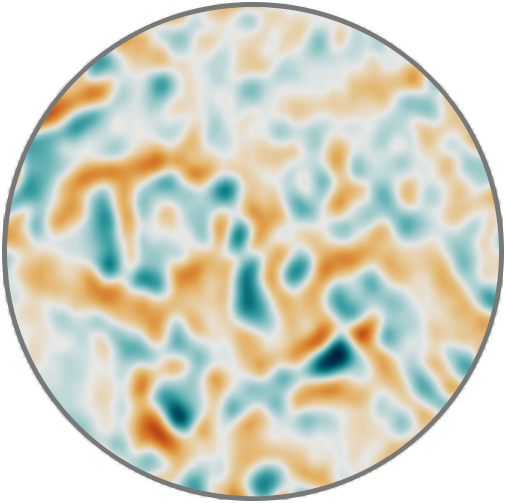The direct observation of the emergence of a new phase in a solid is the analog to the much-discussed molecular movie of a chemical reaction.

Spatially resolved view on the transient changes of the X-ray absorption during the insulator-to-metal transition in vanadium oxide, induced by an ultrashort laser pulse. The differently colored regions of increased (green) and decreased (red) absorption which are about 100-200 nanometers in width largely correspond to regions resting in the metallic or insulating phase before the laser excitation, respectively. The circular field of view has a diameter of 1.66 µm. | Fig. MBI
Now, an international team of researchers has demonstrated for the first time the use of a new lensless X-ray method to image such phase transitions ultrafast. The method described in Nature Physics enables the investigation of the dynamics of quantum materials at the nanometer-scale in the most direct way.
The use of light to produce transient phases in quantum materials is a novel way to engineer material properties at the atomic level, such as magnetic order or superconductivity. However, visualizing the growth of a new phase in a solid is not easy, to some extent due to the wide range of spatial and temporal scales involved in the process. And although in the last two decades scientists have explained light-induced phase transitions by invoking nanometer-scale dynamics, time-resolved real-space images of the transitions have not been available.
In the new study published in Nature Physics, an international team of researchers from ICFO in Barcelona, Aarhus University, the Max Born Institute in Berlin, Sogang University, Vanderbilt University, the Diamond Light Source, ALBA Synchrotron, Utrecht University, and the Pohang Accelerator Laboratory has pioneered a new imaging method that allows capturing the light-induced phase transition in vanadium oxide with high spatial and temporal resolution. The new approach is based on hyperspectral imaging at an X-ray free-electron laser, which has allowed them to visualize and better understand the transition from an insulating state to a conducting, metallic state at the nanoscale in this very well-known quantum material.
The imaging method builds on rigorously exploiting the coherence of the X-ray laser beam using holography and related techniques. These lensless imaging methods are applied in a spectrally resolved, "multi-color" fashion. This allows to identify the different phases in the material, as each phase absorbs the different "X-ray colors" differently. In the experiment at the X-ray laser facility at the Pohang Accelerator Laboratory in South Korea, the scientists used these absorption fingerprints to image how the different phases in vanadium oxide transform into each other after an exposure by an ultrashort infrared laser pulse rapidly heating up the material. This can be done with extremely high temporal resolution, allowing to create a movie of the process with images only a fraction of a picosecond apart.
When analyzing the data, the research team found that pressure plays a much larger role in light-induced phase transitions than assumed so far. While previous studies on the light-induced phase transition in vanadium oxide without spatial resolution have suggested the transient emergence of a truly non-equilibrium phase in the material, such exotic phases cannot be seen in the movie recorded with nanometer resolution. Instead, the researchers argue that the ultrafast transition within tiny regions of the sample intrinsically leads to giant internal pressures millions of times higher than atmospheric pressure. This pressure locally strains the crystal lattice which in turn changes the material properties. The time it takes to relax makes it seem like there was a transient phase. Using hyperspectral X-ray imaging, the research team concluded that in the case studied, the dynamics observed can be explained based on strain arguments alone, without having to postulate the existence of an exotic phases.
Beyond the concrete results on vanadium oxide, the hyperspectral x-ray imaging approach demonstrated has the potential to help solve scientific questions in many areas, such as on processes in catalytic materials, in superconductors, or within nanoscale devices during operation.
Ultrafast X-ray imaging of the light-induced phase transition in VO2
Allan S. Johnson, Daniel Pérez-Salinas, Khalid M. Siddiqui, Sungwon Kim, Sungwook Choi, Klara Volckaert, Paulina E. Majchrzak, Søren Ulstrup, Naman Agarwal, Kent Hallman, Richard F. Haglund Jr, Christian M. Günther, Bastian Pfau, Stefan Eisebitt, Dirk Backes, Francesco Maccherozzi, Ann Fitzpatrick, Sarnjeet Dhesi, Pierluigi Gargiani, Manuel Valvidares, Nongnuch Artrith, Frank de Groot, Hyeongi Choi, Dogeun Jang, Abhishek Katoch, Soonnam Kwon, Sang Han Park, Hyunjung Kim, and Simon E. Wall
Nature Physics (2022)






